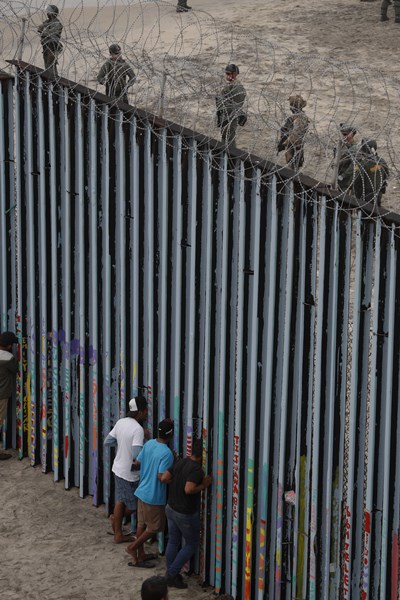President Donald Trump’s predecessors have circumvented Congress before on issues the legislative branch had tried to stop. They have redirected resources appropriated by  lawmakers. They have resorted to the same National Emergencies Act that Trump is invoking in order to build the Wall along the country’s southern border. None of their actions triggered a reaction as immediate and as virulent, however, as Trump’s announcement on February 15.
lawmakers. They have resorted to the same National Emergencies Act that Trump is invoking in order to build the Wall along the country’s southern border. None of their actions triggered a reaction as immediate and as virulent, however, as Trump’s announcement on February 15.
The declaration was immediately attacked by Democrats and in the media as an abuse of presidential power that violated both the Constitution and the authority of Congress, a cynical move not warranted by events. On February 22 House Democrats introduced a joint resolution, just one page long, which declares that the national emergency “is hereby terminated.” Even if four Republicans subsequently support the resolution in the Senate, Trump will kill it with his first veto.
The courts present a more serious challenge. Trump acknowledged that the administration expected to be sued, that it was prepared for “a bad ruling . . . and then we’ll end up in the Supreme Court.” Indeed, by the last week of February his decision had already drawn five lawsuits, including one from a coalition of 16 Democratic states led by California and another from the Sierra Club and ACLU. All of them made the same key points: There is no real border emergency, immigrants are not disproportionately responsible for crime, and no barrier will stop the influx of drugs. Regardless of the reality of an emergency, they claim that Congress, not the President, should decide how to spend federal dollars.
On this form it is an even bet that Trump will prevail. Let us paraphrase the Supreme Court’s June 2018 ruling upholding his travel ban. The statutory basis for the Wall “exudes deference to the president in every clause,” and “the admission and exclusion of foreign nationals [is] a ‘fundamental sovereign attribute exercised by the Government’s political departments largely immune from judicial control.’”
As for the power of the purse, to build the Wall Trump intends to use $600 million from a Treasury forfeiture fund, $2.5 billion from Defense Department drug interdiction money, and $3.6 billion from military construction projects. His declaration applied only to the last of the three. Even if the emergency declaration loses, he’ll have over $4 billion in the kitty.
It is unlikely to lose, however. The National Emergencies Act does not say what exactly constitutes an “emergency.” The lawsuits stress that Trump undermined his own case by saying, “I could do the wall over a longer period of time. I didn’t need to do this, but I’d rather do it much faster.” That remark was careless, and Trump’s Rose Garden performance lacked a sureness of touch, but it does not matter. In its travel-ban ruling the Supreme Court decided that “the statements of a particular president” (i.e., his campaign pledge to keep the Muslims out) are not at issue, but rather “the authority of the presidency itself.” On the whole, the Supreme Court’s travel-ban ruling is neatly applicable to both statutory and constitutional arguments at stake today.
As for the moral issues involved, virtually all Democrats of note—from Nancy Pelosi down to the inimitable Alexandria Ocasio-Cortez—have declared the Wall “immoral.” (Oddly enough they have pointedly refused to characterize Israel’s effective security fence in similar terms.) In reality they don’t want it because they don’t want to stop illegal immigration.
The appeal by Pope Francis in his address to an interfaith conference in Abu Dhabi on February 3 (“let us commit ourselves against the logic of armed power, against . . . the arming of borders, the raising of walls”) is equally incongruous. It is reminiscent of the Pontiff’s assertion, three years ago, that a person who thinks of building walls instead of bridges “is not Christian.” Such assertions need to be examined in the light of history.
Had it not been for the walls, Christendom would not have survived the onslaught of Islam, notably during the sieges of Vienna in 1529 and 1683. Two centuries earlier, in July 1456, 6,000 Christian soldiers successfully defended the walls of Belgrade from Sultan Mehmed’s army of 50,000. During the siege Pope Callixtus III ordered the bells of all churches to be rung every day at noon, as a call to prayer for Belgrade’s defenders. In 1565 the walls of the Grand Harbor in today’s Valletta enabled fewer than 7,000 Christians to withstand an assault by 50,000. And yes, the Vatican is surrounded by the Leonine Walls, 40 feet high and 12 feet thick, erected by St. Leo IV (an eminently “good Christian”) in 848-52 to defend against the Saracens. They still stand, and their gates are protected by Swiss guards with metal detectors and other paraphernalia of strict border security. Thank God for the walls.
The Democrats’ a priori opposition to any form of effective physical barrier along the southern border is illogical and immoral. It reflects their self-serving agenda: the demographic replacement of real Americans by welfare-dependent, unassimilable aliens. They must be stopped. It is in the American interest that the Wall be built as soon as possible, and that the number of illegals entering the country be eventually reduced to zero. That goal may not be fully attainable, but it should be proclaimed as one of the pillars of Trump’s 2020 campaign.
Leave a Reply